Tag: viticulture
The Great Experiment — Transplanting Cab Franc
Another busy weekend in the vineyard. We transplanted four Cab Franc vines from Fairfax, researched and ordered a deer fence, and installed the bottom, or fruiting wire on our trellises in Afton. And, of course, we spent some time admiring the fruit of our labors from the previous few weeks – 150 new vines buried under mounds of dirt. The reds, which
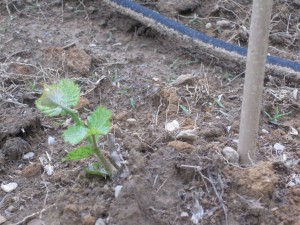
Three weeks after planting, the Viognier, pictured here, and the Petit Manseng, are emerging from the mounds of dirt that protected them from the spring frosts.
we planted two weekends ago, were still hidden away, but the whites we planted a week earlier – the Petit Manseng and the Viognier – were poking through the hills, and we were just thrilled to see them pushing through the earth! I have to say, they emerged from the mounds at just the right time, avoiding the frost that killed off our two prize Mammolo Toscano vines the previous weekend. Frost is an issue that we’ve been giving a lot of thought to after our experience this winter, and it influenced our decision on where to locate the fruiting wire. More on that in a future post.
For today, I’ll simply focus on our grand experiment, the transplanting of four of our Cab Franc vines from Fairfax to the Afton vineyard. We had planted a total of seven Cab Francs in Fairfax to get a bit of hands on experience close to home. I suppose at the back of my mind I thought I might eventually make a little wine from those vines, but mostly I
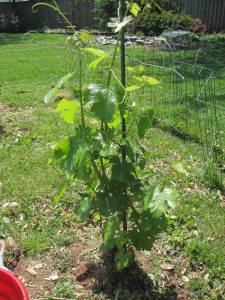
The Fairfax vines looked magnificent this Spring -- if a bit unruly. They need to be pruned, but that, I decided, would wait until they reached their new home.
wanted the experience of being able to go out in the evening after work to care for them and learn from that effort. We planted another five of the same clone and rootstock in Afton to see how the same vines would do in a different environment.
The Fairfax vines grew fast and they looked just beautiful. Clearly, the soil in Fairfax is rich, lending itself to high vigor growth. That’s good and bad, but probably mostly bad. It’s great to see the vines shoot up quickly, but ideally, we’d like them to struggle a bit so that the energy of the plant goes toward the grapes, not the vine itself. Left to its own, the vine will grow as high as it can find support – up a tree, for example, pushing toward the sunlight – but spectacular as that vine might be, Continue Reading–>
Planting the Vineyard, Part I
With the trellis posts finally in the ground, we were finally ready to plant. And not a moment too soon.
When we arrived in Afton on Friday evening, March 30, we had 50 dormant vines waiting for us: 25 Petit Manseng from Vintage Nurseries in Wasco, California, and 25 Viognier from Sunridge Nurseries, Bakersfield, California. The largest number of vines we had ever planted before was seven, and we weren’t sure how long it would take to get
these vines in the ground, or even if we’d be able to get it done by the end of the weekend. But we had another 100 vines set to arrive the following weekend, which meant we didn’t have much of a choice. We decided to plant the Petit Manseng first, and prepared them by putting them in a bucket of water to soak overnight.
In the morning, we inspected the vines to see if they looked healthy. This was kind of like the time in high school when my car wouldn’t start as I was taking my date home. I opened the hood, looked inside as though I knew what I was doing, and just prayed it would start when I got back in the car. It did start up, Continue Reading–>
An Hour of Frost
Well, it doesn’t take much. The forecast called for temperatures in my part of Fairfax County to dip below freezing for less than two hours, but that was enough to do some damage. At least one of the vines appears to have sailed through the night with flying colors, but the others experienced at least some degree of frost damage. As noted in my
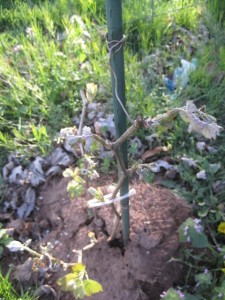
- Some damage on this vine – it’s hard to see in this picture, but compare the shriveled leaves on the right with the green, healthy ones on the left side.
previous post, this is a critical time of the year for vines. Late frost is a threat in any year, but the early bud break this spring left vines everywhere in the state exposed to the threat of frost in the weeks ahead.
As WineMaker magazine noted, late frost is a danger “because the first green growth produced on a new grapevine shoot is two or three basal leaves, immediately followed by the embryonic flower clusters that will become this year’s crop. So, if frost strikes, it can greatly reduce or even wipe out the whole vintage.”
For my vines in Fairfax, I believe the danger is even more acute because they are still small and the buds are so close to the ground, where the temperature is coldest. We’re still new at this, and it’s possible we pruned them back too far over the winter. For the vines we plant this spring, we’ll definitely be focused on strategies for dealing with late frost, and I’ll talk about some of them in an upcoming post.
Of course, one of the most important considerations in dealing with frost is site selection, and we’ve already cast that particular die. The Fairfax vineyard is challenged on at least two counts. It’s at a low elevation, and it’s on flat ground, so the cold air has no place to go. In Nelson County, where we have some vines planted and are preparing to plant another 150, the elevation is higher, around 750 feet, but not high enough to put us in the atmospheric sweet spot that probably runs from about 800 to 1,600 feet above sea level. On the other hand, the land is sloped, so the heavier cold air should flow down hill and off the vineyard. We’ll see.
But no matter how well you plan, you may still find yourself dealing with late frost. I suspect most commercial vineyards in the state were monitoring the vines throughout the night and taking steps to mitigate the frost threat. Larger vineyards have a number of tools they can bring to bear, including wind machines, heaters, and helicopters. Many vineyards gather the wood pruned from the vines over the winter and leave it at the end of the rows to burn on nights where frost threatens.
This year, we didn’t have a lot of choices beyond praying and hoping. However, the Fairfax vineyard is only experimental; I’m not expecting to ever make wine from those grapes, although it would be a definite bonus if I do. But for the vines we are putting in the ground this Spring, we’ll probably have some sleepless spring nights in our future.
The Perils of an Early Spring
We arrived home Sunday afternoon to find that the vines in our Fairfax vineyard were blooming in a magnificent way. I had pruned them during the winter, when they were still dormant, and have been wondering ever since if I had cut cut them back too severely. When I saw them on Sunday, though, I felt vindicated. Yes! Yes ! They would be up to the first wire (30 ” – or maybe 36″, I actually haven’t put the trellis in yet) in no time flat, I assumed.
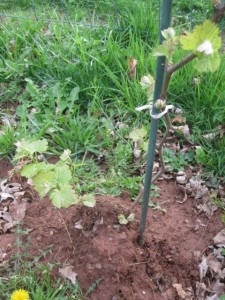
The Fairfax vineyard is a bit overrun with weeds right now, but you can see the leaves on this vine if you look closely.
I couldn’t have been happier. Until I showed the vines to my wife, the Vineyard Goddess.
“Well, that’s good and bad,” she said. Good, of course, because the vines looked so healthy and productive. But mostly bad, because, it’s still March and we could have some frost ahead of us. The bud break I observed on my vines had come very early in the season. And when she glanced over my shoulder at this post, she added another rule of thumb for vineyard management: “March will always be too early for bud break.”
And of course she was right. (She’s pretty much always right. Thank God she’s watching over our vineyard.) This evening, I found an email alert from Tony Wolf, the Virginia Tech viticulture specialist, and probably the state’s foremost expert on all things viticultural, warning of the likelihood of freezing temperature overnight. According to NOAA ‘s web site, temperatures will drop to about 31 degrees tonight in Afton, the site of our Nelson County vineyard, and 30 degrees in Fairfax, where the aforementioned vines are Continue Reading–>
Building the Trellis, Part I
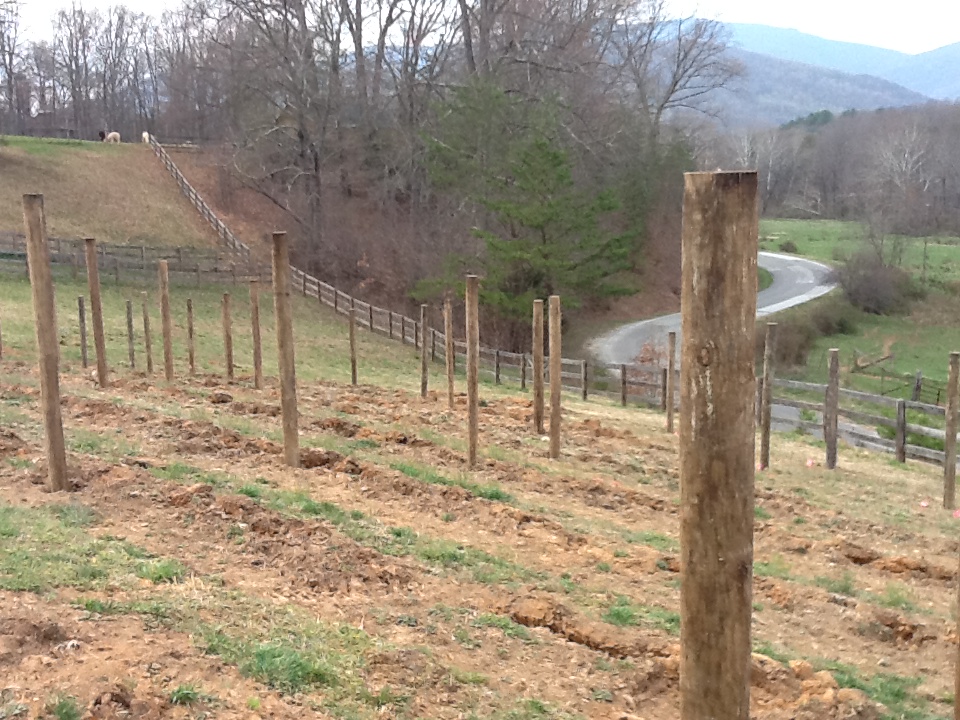
Here's how the vineyard looked last weekend, March 17. The posts are in the ground, the rows have been ripped, and it's beginning to look like a real vineyard! You can see our neighbors, the Alpacas, on the hill, top left.
How we built the trellis
Well, I have to be honest, I didn’t exactly build it myself. Much as I wanted to install the posts with my own hands, I ended up short on time with the planting season upon us. We needed to get the vines in the ground, pronto.
I’d spent much of the winter, between viticulture classes, my job and all of the work that goes into maintaining two separate properties, thinking about how to handle the trellis. There were moments when it seemed simple enough — eight foot posts put 24 to 30 inches into the ground, plus some kind of end-post system, which would be only slightly more complicated. And then, there were times when I wondered if I was up to the job.
As part of the planning, I did some research on what kind of equipment I’d need to buy or rent. A lot of the literature suggests that the best way to put posts into the ground is to pound them in, but the equipment involved would have made that impractical for me to do on my own. The easiest way to get the posts in is to drill the holes with an auger.
So, I briefly considered the idea of a hand-held power auger, which was the least expensive approach, or an auger for my tractor. I spent a lot of time visualizing the process, and considering whether it would be more cost-effective to do it myself or hire someone to do the work. I was pretty confident I could get the line posts in without a problem, but I spent a lot more time worrying about the end posts, which are more complicated. At some point, I began waking up at 4 a.m. to worry about how much work needed to be done and wonder if the vines we had ordered were destined to just, uh, rot on the vine? No, bad metaphor. Go to seed? mmmm…. no, that doesn’t work either. Wither and die? Well, something like that.
Eventually, we passed the point where I could reasonably expect that it would be Continue Reading–>
Dormant Winter Pruning — and other Vineyard Considerations
After a long winter that sometimes seemed like it would never end, spring planting is just around the corner. And despite all the time we had to prepare for the new season, we are now feeling not quite as ready as we’d like to be.
We’ve ordered 150 vines –50 Petit Verdot, 50 Cab Franc, 25 Viognier and 25 Petit Manseng – and lately I’ve been waking up in the middle of the night wondering if we’ll have everything in place in time to plant. I’m still worried, but we’ve made enough progress lately, especially this weekend, that I’m feeling a bit better about the whole enterprise.
Our biggest concern is the trellis. If you’ve followed our progress through this blog, you’ll note that I didn’t worry about that last Spring when we planted 14 vines, split between our Fairfax and Nelson county properties, but that was different on a couple of counts. First, those vines were more for our education than for the eventual production of wine. And we’ve learned a lot from taking care of those vines. Wine in two years would be a bonus, but it wasn’t the goal when we planted them. The second reason I didn’t obsess over the trellis is that I didn’t expect those vines to reach the height of the first wire in that initial year. And since there are so few Continue Reading–>
Every Grape is Different — Notes from a Vineyard Conference
The Virginia Vineyards Association brings together commercial grape growers, hobbyists and others with an interest in viticulture, and its efforts to promote cooperation and the exchange of information is one of the reasons that the Commonwealth’s wine gets better every year. I believe, and I think most of the growers who participated in the association’s technical meeting in Charlottesville last week would agree, that the reputation of Virginia wine is influenced by every bottle that’s sold. If someone has a bad experience the first time they taste a Virginia wine, they may never try another. So all of us have a vested interest in doing what we can to help each other make the best wine possible.
Another reason for the success of the Virginia wine industry is the work that’s being done at Virginia Tech by folks like Tony Wolf, Bruce Zoecklein, and Mizuho Nita, all of whom played major roles at the meeting. Tony Wolf’s book, Wine Grape Production Guide for Eastern North America, has become our bible as we move toward planting a small hobby vineyard, and Mizuho Nita’s blog is the indispensible guide to grape disease management.
However, this was my first encounter with Dr. Zoecklein, and I’m hopeful now that it won’t be my last. Dr. Zoecklein has written the book (actually, at least four books and too many articles to count) on wine chemistry, and he manages to make the chemistry both accessible and practical for people like me. And since this was a class on “Sensory Evaluation for Grape Growers,” he taught the class through the tastes and aromas of seven separate wines, which we tasted blind throughout the class. Continue Reading–>
A night in the Vineyard — with Snow
Before explaing why we found outselves in the vineyard late last night with the snow coming down, let me give you a little background, which hopefully will assure you that we are not crazy. Not completely, anyhow.
In my last post, I talked about the importance of weather in vineyard management. Obviously weather is a factor in all things agricultural – there’s not a farmer in the world who doesn’t keep at least one eye on the sky throughout the growing season – but it raises very specific and difficult issues when it comes to viticulture. Vines, after all, aren’t annual crops. It takes three or more years to bring vines to the point where a crop can be harvested, and they can be be expected to bear fruit for decades after that, which means they must be nurtured through hot, humid summers and cold winters.
I also talked about the importance of site selection in my last post, and it turns out that many of the issues in selecting a vineyard property boil down to coping with weather.
For example, a late frost can cost you an entire growing season. No grapes, no wine, and (if this is your business), no money – although you’ll still have to undergo the expense of caring for the vines throughout the growing season And a serious winter freeze – one in which temperatures drop well below zero – can cost you the entire vineyard. That’s why wine-grape growers in Virginia look for property with an appropriate elevation. In much of the area east of the Blue Ridge Mountains, elevations above 800 feet are highly desirable, since they bring you into a sweet spot of a thermocline where warmer air is trapped. Optimal elevations, those within a thermal belt or thermocline, vary by region. In our area (the Monticello AVA), I believe that elevations of 800 to 1500 feet above sea level (ASL) are optimal. Any higher or lower and you risk problems from frosts and freezes. Continue Reading–>
Finding the Perfect Spot to Plant Vines
It’s hard to imagine anything more important to the establishment of a great vineyard than the selection of the right piece of land, yet hardly any step gets less attention from home vintners. That’s because most of us use the land we already have. And even those of us who search for a property with a vineyard in mind sometimes give less than full attention to the site’s suitability for growing wine grapes.
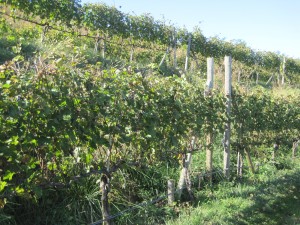
- Slopes are good for vineyards, but this is almost too much. Try getting your tractor across it without tipping.
I can attest to that. Before buying our Nelson County home, we looked at something on the order of 45 properties. Initially we set our parameters at five acres or more, preferably 10. We excluded properties that were wooded (“private” in real-estate speak), and those that were at too low an elevation to provide safety from winter freezes. We wanted slope, we wanted an eastern aspect, we wanted land that was so infertile that a farmer would turn his nose up at it. (Bad soil is ideal for wine grape production, but that’s a story for another post.)
And in the end, we bought a property that was only three acres, with a western aspect and tall trees on the eastern border that would limit sunlight in the morning. So what in the name of all that’s holy were we thinking?
Well, this is the home we plan to retire to in a few years, and we pretty much just fell in love with it. It’s a great house with beautiful mountain views. And it does have a few things going for it as a vineyard property: slope (almost too much slope), really crappy soil, good drainage, and a small section at the western end that we believe will get sufficient sunlight for grape production. Continue Reading–>

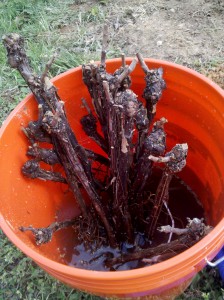
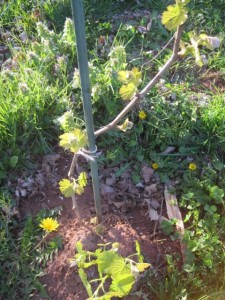
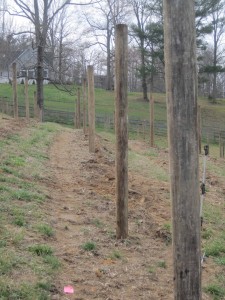
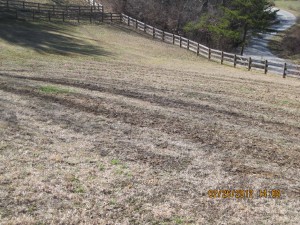

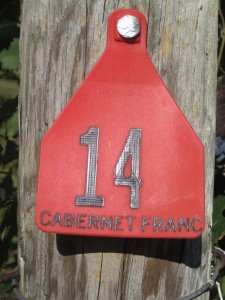
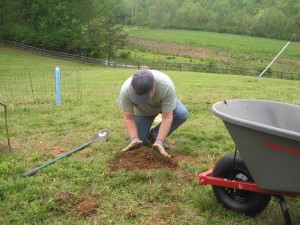


Recent Comments